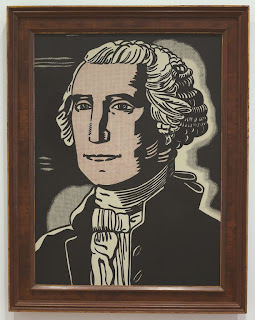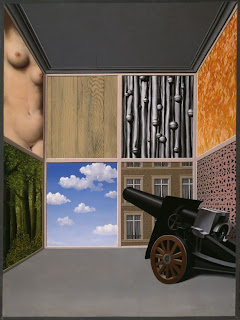Kudos to the geniuses who decided to have the “two sisters” dress up as the Renoir. Instant classic.
Needless to say, we haven’t been able to get the song out of heads, particularly the hook warning visitors to “expect the unexpected” at the Art Institute. Sure, it’s a cheesy jingle from the 80’s, but the statement rings no less true now then it did then, both for visitors and educators.
I had my first and only Roads Scholars tour this past week and despite my planning, there was nothing I could have done to prepare me for what was in store. I did the tour alongside Terah Walkup (she is AWESOME by the way, just in case you didn’t already know) covering European Modernism & Contemporary Art. We surveyed Surrealism, Abstract Expressionism, Pop Art, Minimalism, and Contemporary, all in a brief hour and a half that went as quickly as it came. I tackled Surrealism with Magritte’s On the Threshold of Liberty, 1937 and Pop Art with Lichtenstein’s George Washington.

Roy Lichtenstein, George Washington 1962

The Road Scholars program members visited the AIC for three days participating in gallery walks, talks, and related gallery programs. They differ from most visiting groups in that the majority of them are not casual museum goers and have formulated views and theories on art. This makes the resulting tours more challenging and the ensuing conversations more in-depth than those you normally get on a Highlights Tour on a Thursday night.
I started off with the Magritte and Surrealism and everything was going exactly as planned (a sure sign that something is about to go wrong) when a woman cut me off to inform me that not only did she not like nor care about the piece but that she didn’t know why anyone else should care either. I expected that type of comment and question further along our tour during Minimalism or Pop Art (based off of past groups reaction to those movements) but certainly not that early on in our tour.
I wanted to answer her question with my personal opinion, but I figured it would be better to let her colleagues and fellow Road Scholars tackle it for her. Why exactly should we care about this work? The result was a series of colorful, intelligent, and honest responses from people not necessarily defending the work, but suggesting that one need not like a work of art to appreciate what it represents from an art-historical perspective. Some commented on the technical and aesthetic qualities of the work while others on the content and its significance. After it all, she may still not have liked Magritte’s work, but her nods and smile hinted at a newfound way of looking and appreciating art. I’d consider that a small victory for art!

No comments:
Post a Comment